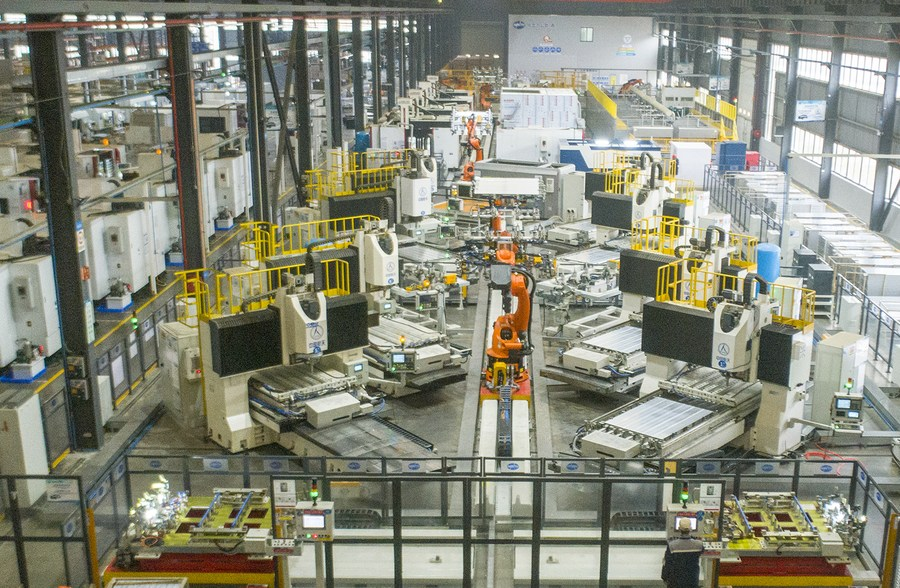
Aerial photo taken on Dec. 16, 2021 shows the automated production line of a technology company in the Economic Development Zone of Anji County in Huzhou, east China's Zhejiang Province. (Photo by Xia Pengfei/Xinhua)
BEIJING, May 2 (Xinhua) -- Faced with the global economic challenges posed by the COVID-19 pandemic and geopolitical factors, Chinese enterprises are braving the headwinds with the support of a variety of government policies.
China's industrial and services sectors have demonstrated resilience of growth despite disruptions, while entrepreneurs' endeavors in optimizing products and operations are adding new vitality to the market.
RESILIENCE OF INDUSTRY, SERVICES
China's value-added industrial output of major enterprises went up 6.4 percent year on year in the first quarter of the year (Q1), contributing to 2.1 percentage points of the economic growth, data from the National Bureau of Statistics (NBS) shows.
The added-value of the manufacturing sector rose 6.1 percent year on year, up 1.3 percentage points from the same period last year, while that for the financial sector and the sector of information transmission, software and IT services climbed 5.1 percent and 10.8 percent, respectively.
The profits of China's major industrial firms rose 8.5 percent year on year in Q1, with 24 out of 41 industries seeing a year-on-year profit growth, said the NBS.
"Even with the resurgence of COVID-19, our production and sales in China have remained relatively stable," said Zhang Weiwei, supply-chain director of Karcher Trading (China) Co., Ltd., a German manufacturer of high-pressure cleaners.
According to Zhang, the instability of the global supply chain has further strengthened the company's determination to pursue its localization strategy. "We will continue to increase investment in R&D, production and sales in China," Zhang said.
China's services industry also expanded in Q1, with the index gauging its output rising 2.5 percent year on year, and the combined revenue of major firms up 13.6 percent in the first two months.
Although contact-based sectors have taken a hit amid Omicron variant infections in March, businesses have reached a rather active level in modern service sectors, including insurance and telecommunications, radio, television and satellite transmission services.
New consumption forms have thrived, driven by the in-depth integration of 5G, artificial intelligence and the Internet of Things, which have promoted consumption upgrading and unleashed the potential of new businesses in the services sector, said NBS statistician Li Suoqiang.
Amid China's pursuit for high-quality development, the stellar performance of the high-tech industrial and services sectors has highlighted the vibrancy of Chinese enterprises.
The value-added industrial output of China's major high-tech manufacturers jumped 14.2 percent year on year in Q1, 7.7 percentage points higher than that of the major industrial firms, while their profits and fixed-asset investment went up 3.8 percent and 32.7 percent, respectively.
During the same period, the country's high-tech services industry saw fixed-asset investment rise by 14.5 percent year on year and foreign direct investment in actual use soar 57.8 percent, NBS data shows.
"The long-term economic fundamentals remain sound and the continued momentum of economic recovery has not changed," NBS spokesperson Fu Linghui said.
WORK WAY OUT WITH STRONGER SUPPORT
At an international trade market in Yiwu, east China's Zhejiang Province, sales person Kauthar Ding talks via video with clients thousands of miles away, introducing various crystal products with the help of a selfie stick.
Since the pandemic began, this kind of online trading practice has become commonplace in the Yiwu market, which is located in China's small commodity hub and used to receive many foreign clients.
Chinese entrepreneurs have made efforts to cope with the market changes at home and abroad. For example, with eat-in services seriously hampered, restaurants on popular dining streets in Beijing and Wuhan have expanded food-delivery services. Meanwhile, toy makers have designed products with interactive functions to attract more foreign buyers.
Placing the concerns of its 150 million market entities high on its policy agenda, China has unveiled a string of supportive measures, smoothing industrial and supply chains, easing tax and fee burdens, and increasing financial assistance.
To help factories resume production amid COVID-19 disruptions, China established a "white list" approach to support the resumption of work for key companies in the industrial chain and minimize the impact of COVID-19 on the supply chain.
Official data shows that the country's tax authorities have provided a total of 333.5 billion yuan (50.40 billion U.S. dollars) in tax and fee deferrals for micro, small and medium-sized manufacturing firms nationwide in Q1, while about 1.5 trillion yuan of value-added tax credit refunds will be completed this year.
More financing support has also been granted to cash-strapped companies, with data showing a 24.6-percent year-on-year increase in outstanding inclusive loans for smaller companies by the end of March.
The country's central bank lowered the reserve requirement ratio for financial institutions by 0.25 percentage points in late April, expecting to free up 530 billion yuan in long-term liquidity into the market.
On the fiscal front, 3.65 trillion yuan of special-purpose bonds for local governments are about to be issued this year, while the national general public budget will be increased to 26.71 trillion yuan.
Amid this support, China's market entities are thriving. The number of newly-added market entities reached 2.95 million nationwide in March, up 19.3 percent year on year. Of the 498 listed companies that have released their forecasts for Q1, 387 expect net profit growth.
"Once the epidemic is contained, our business will rebound in about a month and quickly return to normal levels," said Wu Hai, founder of Mei KTV, a karaoke-bar chain. "That's how we've gone from a few dozen stores two years ago to 200 now." ■



